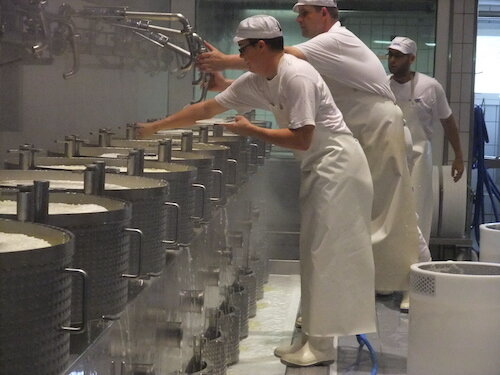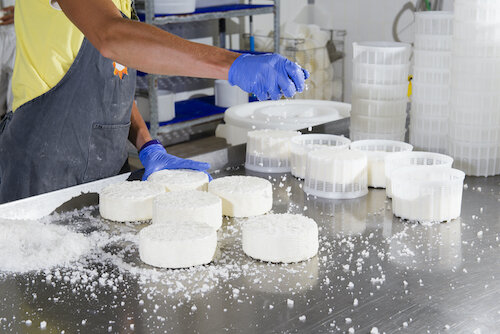From Milk to Wheel - Cheesemaking 101
Making cheese
“A cheese may disappoint. It may be dull, it may be naive, it may be oversophisticated. Yet it remains cheese, milk's leap toward immortality.” Clifton Fadiman
Cheese is a unique food, making so much from so little. Milk can be transformed into cheese with nothing more than salt, rennet, temperature, and time. While making cheese follows fairly straightforward steps, all along the way there are chemical and biological complexities taking place.
Here are the basics of cheesemaking.
It all begins with milk
Mammals produce milk, but not all milk can be used for making cheese. In the United States, we are most familiar with versions made from the milk of cows, sheep, goats, and even buffalo. Venture elsewhere in the world and you’ll find cheeses made from the milk of donkeys, horses, and yaks. All these animals, and many others, produce milk that is rich in calcium, lactose, proteins...everything a growing baby needs. This is where it all begins.
The main protein in milk is casein, accounting for nearly 80% of the volume. A particular protein, K-casein, is needed to make cheese because it helps coagulate the milk. Without enough of this protein, the milk will just stay liquid. Only some ruminants (hoofed animals who chew cud) have this protein.
Regardless of the source of the milk, quality is absolutely paramount. Not only will fresh milk yield a much better tasting cheese from having higher-quality fats, proteins, and sugars, but it will also perform better in each step of the cheesemaking process.
The first task in cheese making is heating the milk within a specific range of temperatures, usually around 100°F. Doing so creates an environment where lactic acid bacteria can thrive. These bacteria consume the lactose present in the milk and produce lactic acid, which acidifies the milk and inhibits the growth of harmful bacteria.
Cutting the curds
In with the curds, out with the whey
Once the milk is at the correct temperature, it’s time to separate the solids (curds) from the liquid (whey). These curds are the building blocks of what will ultimately be cheese.
There are essentially two ways to do this. The first method is by adding an acid such as lemon juice or vinegar to the heated milk, thus curdling the milk. Using acid yields curds that are small and pebbly, like those found in ricotta cheese or queso fresco.
The second, and likely oldest, method is adding rennet to the heated milk. Rennet is a complicated array of enzymes found in the stomachs of ruminant animals. The main enzyme needed for cheesemaking is Chymosin, needed for the curdling to occur. The rennet alters the milk, encouraging the curds to form. Most rennet used in cheesemaking comes from the stomach linings of animals, although plant-based and even synthetic versions are available to meet the needs of producers who prefer those options.
At this stage, the curds are little more than gelatinous chunks. This pliability is useful because it allows them to be stretched and manipulated as needed (think mozzarella, for example). Once the curds form, the whey is typically drained off and reserved for other purposes.
Making the wheel take shape
Once the curds are separated from the whey, they are handled according to the recipe being made. Many recipes call for the curds to be heated and salted to further drive out moisture. The heating allows the curds to be pressed together more intensely for a firmer final product, and the salting helps retard spoiling as well as adding flavor.
The curds are often scooped and pressed into molds of different shapes and sizes to begin forming wheels. As they dry further, the wheels become denser and easier to handle without breaking apart. Many recipes call for washing or submerging the wheels in a brine solution. This further reduces any chances for spoilage, and it also lowers the acidity of the cheese, giving it a milder flavor.
At this stage of the cheesemaking process, different techniques may be employed to steer the developing cheese toward the desired outcome. Cheeses like feta will remain brined, fresh cheeses can be consumed in this condition, and cheeses destined for aging will move on to the ripening stage.
Realizing a cheese’s full potential
The practice of aging cheese, called affinage, is where most of a cheese’s unique flavor and texture comes from. Keeping the cheeses in a controlled environment allows the extant microbes to go to work on the proteins and other constituents of the wheel, transforming them into flavorful components.
It is during this part of the process that various techniques may be employed to further develop the cheese in a particular way. Blue cheeses are inoculated with specific bacteria to yield their distinctive blueing and flavors. Certain molds may be applied to the exterior of the wheel to encourage specific traits, as is done with Brie. Wheels are flipped, scrubbed, or washed as they need to be.
Whether days, months, or years are needed for ripening and aging, this stage is where most of the cheese’s final personality is coaxed from the wheel. The more experienced the affineur, the more character the cheese will ultimately exhibit, making as much an art form as a scientific process.




